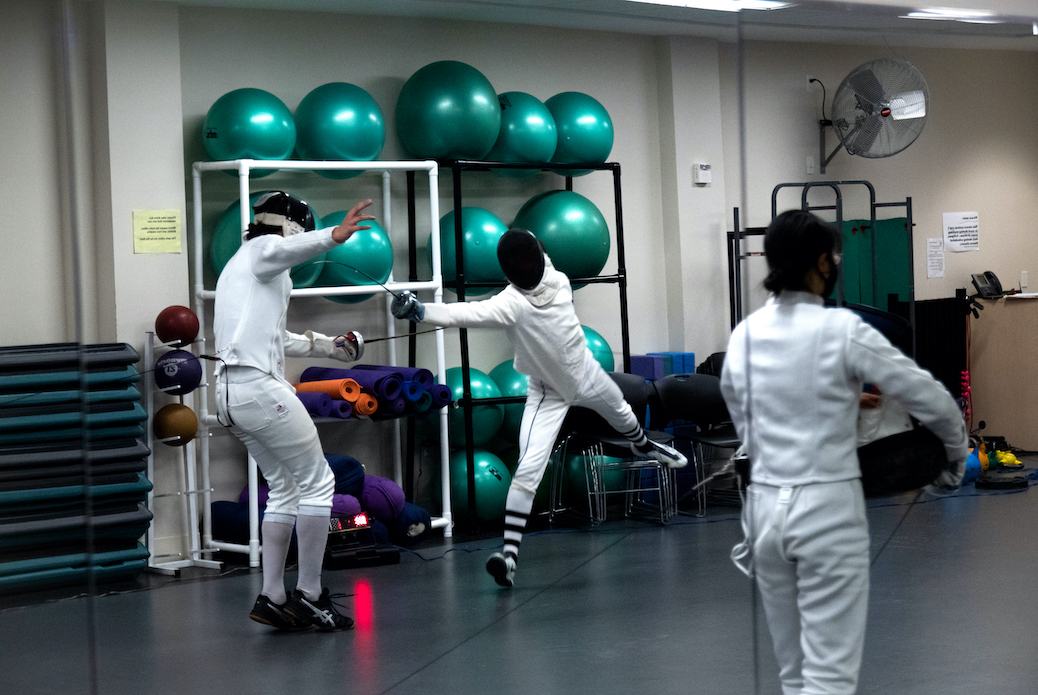No coach, no problem: fencing club is going strong
November 12, 2021
In Room 213 of the Peter Buck Center for Health and Fitness, the same room that holds cycling and yoga classes, a small group of students put their fencing skills to the test three times per week.
These students make up the fencing club, a group of approximately ten students who focus on epee fencing, one of three variations of the sport. The epee is the heaviest of the three fencing weapons, which lends it to a slower, more strategic type of fencing.
“It’s like an advanced game of rock paper scissors,” Tate Taczak ’23 said.
The club team is in a unique position, as it does not have a coach. However, team members have still found ways to develop a training regimen.
“Most of the time we actually pair up and fence each other and then we critique each other,” Taczak said.
Casey Edmonds-Estes ’22 is one of the few members of the team with fencing experience prior to Bowdoin. Because of this experience, he takes on many of the responsibilities in teaching new members.
“In practice, I pretty much do all of the coaching,” Edmonds-Estes said. “[My position] is good in some ways because it gives me a lot of flexibility with what I want to work on.”
However, the fact that the team does not have an official coach has restricted its opportunities to compete against fencers from other institutions, as they cannot register as an intercollegiate team.
The fencers are forced to seek other venues for competition.
“We have to go [to club tournaments] as a club to compete individually,” said Edmonds-Estes.
Edmonds-Estes believes a coach would bolster the longevity and stability of the team.
“One of the things that I had been worrying about is that for a long time, it looked like when I graduated, the club would just die because there was no one else who wanted to [coach],” Edmonds-Estes said. “Fortunately it now seems like that isn’t the case, but there’s always that risk.”
Taczak did not begin fencing until he arrived at Bowdoin. He was immediately drawn to the sport by its strategy and mental intensity.
“It becomes less a game about pure athleticism and more about how you can outmaneuver your opponents, and that to me is partly what’s kept me coming back,” Taczak said.
Edmonds-Estes echoed Taczak’s sentiments.
“There’s so much strategy and so many tactics. So much of [fencing] is just figuring out what your opponent is going to do next and being one step ahead.”
Despite a unique set of challenges, the team will not be disappearing any time soon.
“I’m really excited with where we are and the path that we’re on. We have a bunch of really exciting new fencers,” Edmonds-Estes said. “It’s an energy that I really like and that I think that [the team] is going to keep carrying forward after I graduate.”
 Blakely
BlakelyComments
Before submitting a comment, please review our comment policy. Some key points from the policy:
- No hate speech, profanity, disrespectful or threatening comments.
- No personal attacks on reporters.
- Comments must be under 200 words.
- You are strongly encouraged to use a real name or identifier ("Class of '92").
- Any comments made with an email address that does not belong to you will get removed.

Bowdoin Fencing lives on! As a former Bowdoin fencer, I’m thrilled to hear that the future is bright for this club.